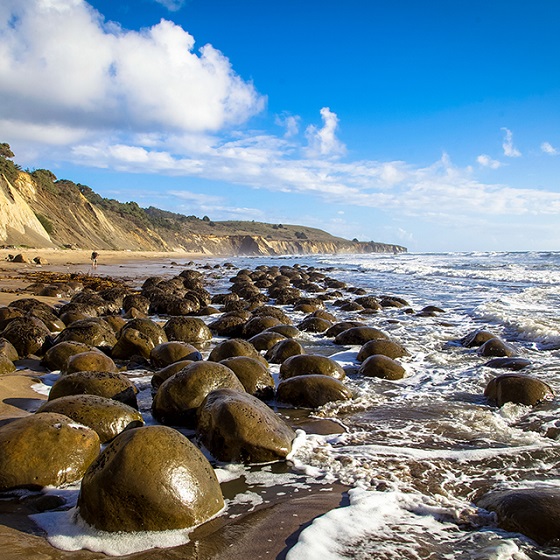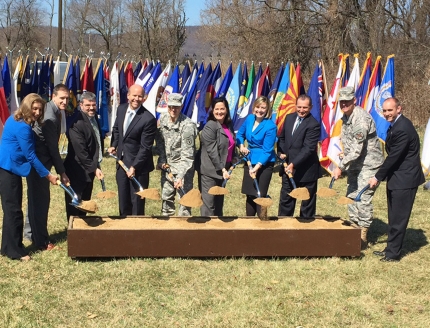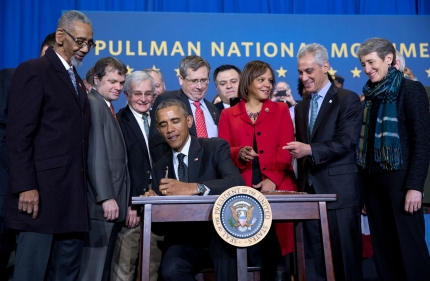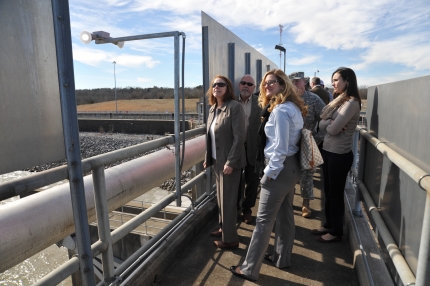Council on Environmental Quality Blog
Driving renewable progress in the Federal Government
Posted by on April 3, 2015 at 5:23 PM EDTEarlier today, the Administration announced new actions to drive growth in the solar industry while also supporting our veterans. Since the President took office, solar electricity generation has increased 20 fold, doubling last year alone.
In the Federal Government, we’re doing our part to drive solar growth. On Wednesday, I visited the Army’s Fort Detrick base in Maryland to break ground on an exciting new solar energy project. The project – which includes more than 60,000 solar panels across 67 acres – will help the base meet its electricity needs by producing 15 megawatts of renewable solar energy, enough to power approximately 2,500 homes.
Projects like this are a great example of how Federal facilities are making huge strides toward cleaner energy production and greater energy independence. They also help ensure that the Federal Government does its part to curb the greenhouse gas emissions that drive climate change. For example, the Fort Detrick solar array will cut greenhouse gases by 19,000 metric tons of carbon dioxide each year. That’s equivalent to the carbon absorbed by more than 487,000 trees.
Last year, through the Capital Solar Challenge, the President challenged Federal agencies and military installations to deploy more solar energy on rooftops, covered parking, and open land. The Fort Detrick groundbreaking marked the first project launched under the Challenge.
And it’s not just the Army stepping up. Other Federal agencies and branches of the U.S. Military are making progress to meet the President’s goals. Also this week, the General Services Administration (GSA) announced a project to produce 5 megawatts of solar on nine GSA and U.S. Forest Service rooftops in California and Nevada. GSA also awarded two contracts for a total of 81 megawatts of new grid-based solar in Maryland. This project is part of a larger green power initiative issued last year for grid-based green power across regional markets, including a 140 MW wind project in Illinois.
The Navy has found success using a similar regional model. They have already announced plans to install new renewable energy projects to power 14 installations in California, and up to 55 megawatts of new renewable for three installations in Texas, as well as new projects for ten Naval installations in the Mid-Atlantic. The entire Department of Defense is leading the way, making significant progress toward their Climate Action Plan goal of deploying 3 gigawatts of renewable energy by 2025. Over the past year, the Air Force developed a 16 megawatt solar array at Davis-Monthan Air Force Base, Arizona and plans to expand its use of renewable energy with more than 160 megawatts under development. And in addition to the project at Fort Detrick, the Army has announced three 30 megawatt solar arrays at installations in Georgia, the first of which is breaking ground later this month.
All of this progress has an impact outside the Federal Government. For example, the Department of Defense’s steadfast commitment to deploying renewables is driving the development of clean energy technologies across the sector. And by leveraging private sector financing through energy savings performance contracts, they are making these strides without costing taxpayers an extra dime.
This is what leading by example look like. All of these projects will help the Federal Government meet the President’s new goal to cut greenhouse gas emissions 40 percent from 2008 levels by 2025. As President Obama continues to take action to curb emissions and support clean energy, he will continue to rely on the impressive leadership Federal agencies are showing.
Christy Goldfuss is Managing Director of the White House Council on Environmental Quality.
Learn more about Energy and EnvironmentPartnering to Save our Endangered Species
Posted by on March 26, 2015 at 4:59 PM EDTEd. Note: This blog post introduces you to Michael Bean, Principal Deputy Assistant Secretary for Fish and Wildlife and Parks.
America supports more than 200,000 unique plants and animals, making us one of the top 10 countries in the world for our wildlife diversity. Our Endangered Species Act (ESA) represents one of the world’s first and best laws designed to protect species. We are proud of the constant innovation that has made us more effective at saving special species and places that matter to all Americans.
Last month, a small fish called the Oregon chub, was declared the first fish to be recovered and taken off the endangered species list. It joins 30 other plant and wildlife species successes announced since President Obama took office, including fully recovered ones and others that never needed federal protection because private and government action turned them around in time.
And now, we have the opportunity to see more of the public-private partnerships that make those recovery successes possible. The U.S. Fish and Wildlife Service announced the approval last week of the first conservation banks that will bring private investment and a market-based approach to conservation efforts in Wyoming.
Conservation banks are an innovation in endangered species policy first launched in 2002, with more than 130 banks now established. At a bank site, private investors or local government permanently protect property and restore habitat to create ‘credits’ measured by the level of endangered species benefits produced. Once benefits for species have been achieved and measured, credits are released and can be used to offset harm that may be caused by a development project happening elsewhere. Conservation banks are just one example of the flexible, win-win approaches possible under the Endangered Species Act (ESA) that help spur wildlife recovery, support farmers and ranchers, and facilitate progress on infrastructure projects.
The new conservation bank in Wyoming is part of an 11-state effort to save a bird called the greater sage grouse. The privately-funded bank will allow impacts in low quality habitat, for example from oil and gas drilling, to be offset with credits for protecting and enhancing habitat in the most important landscapes for the bird’s survival and recovery. The bank protects more than 100,000 acres of high quality habitat for this iconic Western bird now being considered for listing under ESA.
The now-recovered Oregon chub benefited from ‘safe harbor’ agreements with private landowners in Oregon’s Willamette Valley. Those landowners have allowed fish to be reintroduced to ponds and streams on their property in exchange for the promise that they will face no additional regulation as a result of their good actions. More than 40 percent of chub populations are on private lands whose owners are voluntarily participating with this or other federal and state programs.
Through tools like the ones described above, there are already more than 62 million acres of non-federal land across the country where partnerships between local government, private landowners and federal agencies allow wildlife recovery and other activities to fit together. That’s an area bigger than the State of Minnesota. We will continue to find innovative and effective ways to make wildlife conservation efforts more successful while allowing businesses and local communities to thrive.
Michael Bean is Principal Deputy Assistant Secretary for Fish and Wildlife and Parks at the U.S. Department of the Interior.
Learn more about Energy and EnvironmentDiscovering America’s Public Lands, City by City
Posted by on March 13, 2015 at 2:24 PM EDTNo matter who you are, no matter where you live, our parks and our monuments, our lands, our waters -- these places are the birthright of all Americans.
President Obama, February 19, 2015With more than 80 percent of families living in urban areas, finding safe, open spaces to enjoy time outdoors can be a challenge for many Americans. Children, especially, are spending less time playing outside than ever before. But when children get the chance to explore the outdoors and experience nature in America’s unparalleled public lands and waters, they can learn an appreciation that will last a lifetime. It’s our responsibility to give them that chance.
That’s why last month President Obama issued a call to action to get all children to visit and enjoy America’s great outdoors. And today, Secretary of the Interior Sally Jewell launched the 50 Cities Initiative to engage the next generation of outdoor stewards.
Learn more about Energy and EnvironmentProtecting Vital Waters as Marine Sanctuaries
Posted by on March 12, 2015 at 11:57 AM EDTForty years ago, President Ford approved the designation of the country’s first marine sanctuary — the USS Monitor National Marine Sanctuary, protecting the shipwreck of one of the most famous Civil War ironclads. Since then, 13 other marine protected areas have been added to the Sanctuary system, encompassing more than 150,000 square miles of ocean along our coasts, in the Great Lakes, and near the Hawaiian islands and American Samoa.
Like the Monitor, some of these sanctuaries and monuments provide insight into our nation’s history. Others protect areas rich in biological diversity and significant for scientific research and discovery. Many are economically valuable for fishing, tourism, and recreation. Together, the network of sanctuaries helps preserve a natural resource that all Americans depend on, no matter where they live: a healthy and thriving ocean.

And now, the Obama administration is making that treasured network even stronger. NOAA announced today that it is expanding two existing sanctuaries off California’s North-central coast. The expansion will more than double the current size of the Gulf of the Farallones and Cordell Bank national marine sanctuaries, ensuring that we are protecting all that the region has to offer — from its biologically rich habitats primed for fishing and scientific research to the seascapes and shipwrecks that attract tourists and explorers.
Learn more about Energy and Environment2016 Budget Highlights President's Commitment to Conservation
Posted by on February 2, 2015 at 1:07 PM EDT“We are blessed to have the most beautiful landscapes in the world. We have a responsibility to be good stewards of those landscapes for future generations.”
–President Obama, October 10, 2014
President Obama is committed to protecting the air we breathe, the water we drink, and the outdoor spaces we love. That’s why, as he noted in his State of the Union address this year, the Obama Administration has protected more public lands and waters than any administration in history. His Budget Request for Fiscal Year 2016, released today reinforces those commitments, supporting key measures focused on conserving America’s bountiful natural resources and ensuring that all Americans can enjoy them – now and in the future.
That means ensuring that our wondrous national parks are upgraded and maintained to last another century and more. Nothing better captures America’s natural beauty than places like the Grand Canyon, Yellowstone, or Yosemite. That’s why, to mark the 100th birthday of the National Park Service, the budget invests $859 million (including $300 million in mandatory funds) in 2016 to allow NPS over the next 10 years for restoring and maintaining key park facilities like visitor centers, trails and historic structures at our greatest historical, cultural, and national treasures. The National Park Centennial Initiative will also leverage private donations, increase volunteer opportunities in parks and get more young people exploring our public lands and waters.
All Americans deserve the chance to enjoy the outdoors, even if they can’t get to a national park. That’s one of the reasons the President has been steadfast in his support for the Land and Water Conservation Fund (LWCF), a program that has benefited communities in every county in the country over its 50 year history. The Fund reinvests revenues from offshore oil and gas development to support LWCF programs that enhance existing parks, conserve treasured landscapes, preserve historic sites like Civil War battlefields, and open land for all sorts of public uses – from hunting, fishing and hiking to establishing much-needed parks in urban areas. President Obama has advocated for consistent and reliable funding for LWCF programs, and his Budget proposes full funding of LWCF at $900 million annually – the amount equal to the oil and gas receipts that Congress long ago directed be deposited in the Fund to support these important public programs.
As the President continues to expand opportunities for Americans to enjoy the outdoors, he recognizes the need to protect the health of our lands and waters. And that’s impossible without addressing the global threat of climate change. His budget keeps us on a path to take aggressive action to curb carbon pollution and prepare communities for the impacts of climate change. It invests in programs to reduce greenhouse gas emissions from conventional energy development and invests roughly $100 million at the Interior Department to support renewable energy development on our public lands and waters. It also supports steps to strengthen our natural resources in the context of a changing climate. For example, the budget treats suppression of the most severe fire activity the same as we treat other natural disasters. The fix would provide funding certainty in future years for firefighting costs and allow us to invest in programs that will more effectively promote fire risk reduction and long-term forest and rangeland health and preservation.
The budget includes increased support for other measures to strengthen our natural resources and protect our lands and waters. Here are just a few more:
- Restoring Iconic Ecosystems: The budget follows through on the President’s commitment to restore our nation’s most important watersheds and ecosystems. Building on the Obama Administration’s record investment of more than $1.6 billion in the Everglades, the budget proposes $240 million to continue restoration efforts. It also includes $250 million for the Great Lakes Restoration Initiative, $70 million to meet pollution reduction goals in the Chesapeake Bay, and investments in the Gulf Coast and Puget Sound.
- Supporting Private Landowners: No one understands the value of our forests and working lands better than the landowners who earn their livelihood from them. The President is committed to supporting these stewards, and his budget seeks to make the conservation easement tax deduction permanent, so farmers and ranchers have options to get the support they need and the lands they work aren’t converted for other uses. The Budget also provides $1.35 billion to help private landowners and agricultural producers implement a wide range of conservation practices.
- Advancing Science and Tools: The budget also increases funding to advance science and develop tools to strengthen our natural resources. That includes $108 million for research related to the role of our lands and forests as carbon sinks, $30 million to expand NOAA’s ocean acidification research program, and $415 million for the Department of the Interior’s important work to study climate variability and support resilience of our public lands and waters.
Mike Boots leads the White House Council on Environmental Quality. Ali Zaidi is the White House Office of Management and Budget Associate Director for Natural Resources, Energy, and Science.
Learn more about Energy and EnvironmentEnergy Efficiency Through Outdoor Lighting – What a Bright Idea!
Posted by on January 26, 2015 at 4:25 PM EDTOn Friday, the White House launched the Presidential Challenge for Advanced Outdoor Lighting, calling on local governments to accelerate the adoption and use of high efficiency outdoor lighting. In addition to driving carbon pollution reductions in communities across the country, the Challenge will help cities and states cut their outdoor lighting bills by 50% or more. And in the Federal Government, we’re committed to doing our part to improve lighting efficiency and save taxpayer dollars.
Last week, I toured the U.S. Army Corps of Engineers’ infrastructure improvement project along the Tenn-Tom waterway, an impressive feat of engineering that connects the Tennessee River in Alabama and the Tombigbee River in Mississippi. Using long-term energy savings to pay for up-front costs, the Corps’ Mobile District has embarked on a project to improve the Tenn-Tom waterway’s infrastructure. The project will install, replace, or retrofit elements along the waterway’s infrastructure, primarily focusing on the lighting fixtures at its 10 locks and dams. It’s the first-ever energy savings performance contract executed for a Corps civil works project and could set precedent for other Corps districts in utilizing third-party funding for future endeavors.
At first glance, swapping some light bulbs may seem like a small, unremarkable project. But improved lighting is actually one of the most straightforward and commonsense ways to improve energy efficiency. And the benefits are far from small: the Corps expects to save more than $5 million over the more than 20-year lifespan of the Tenn-Tom waterway contract. Beyond the energy cost savings, the improved outdoor lighting is also projected to cut greenhouse gas emissions by 941 metric tons each year.
Other Federal projects have yielded results that are just as impressive. The Army’s Ft. Irwin Rotational Units Maintenance Area recently replaced its inefficient lighting with higher-efficiency LED fixtures. The replacement lights have generated energy savings estimate at 75%, and will result in savings of over $87,000 per year. And the Department of Defense has demonstrated big savings and emissions reductions in other relighting projects and retrofits as well. Ultimately, these successes mean fewer tax dollars spent on energy bills and a reduced carbon footprint – a win-win for the American taxpayer and the environment.
As states and cities across the country answer the President’s call, the Federal Government will continue to lead by example in improving energy efficiency and cutting harmful carbon pollution.
Kate Brandt is Federal Environmental Executive at the White House Council on Environmental Quality.
Learn more about Energy and Environment
- &lsaquo previous
- 1
- 2
- 3
- 4
- 5
- 6
- 7
- 8
- 9
- …
- next &rsaquo
White House Blogs
- The White House Blog
- Middle Class Task Force
- Council of Economic Advisers
- Council on Environmental Quality
- Council on Women and Girls
- Office of Intergovernmental Affairs
- Office of Management and Budget
- Office of Public Engagement
- Office of Science & Tech Policy
- Office of Urban Affairs
- Open Government
- Faith and Neighborhood Partnerships
- Social Innovation and Civic Participation
- US Trade Representative
- Office National Drug Control Policy
categories
- AIDS Policy
- Alaska
- Blueprint for an America Built to Last
- Budget
- Civil Rights
- Defense
- Disabilities
- Economy
- Education
- Energy and Environment
- Equal Pay
- Ethics
- Faith Based
- Fiscal Responsibility
- Foreign Policy
- Grab Bag
- Health Care
- Homeland Security
- Immigration
- Innovation Fellows
- Inside the White House
- Middle Class Security
- Open Government
- Poverty
- Rural
- Seniors and Social Security
- Service
- Social Innovation
- State of the Union
- Taxes
- Technology
- Urban Policy
- Veterans
- Violence Prevention
- White House Internships
- Women
- Working Families
- Additional Issues




